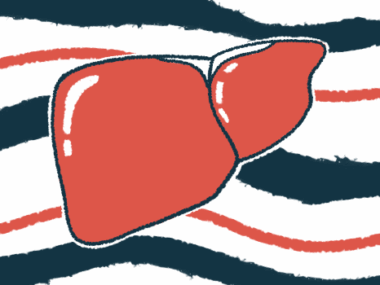PBC treatment setanaxib eases signs of liver damage: Trial data
Both doses tested eased liver damage, stiffness, per top-line data
Written by |

Six months of Calliditas Therapeutics‘ investigational therapy setanaxib safely and significantly reduced signs of liver damage in people with hard-to-treat primary biliary cholangitis (PBC).
That’s according to top-line data from a Phase 2b clinical trial, dubbed TRANSFORM (NCT05014672), that Calliditas shared in a recent company report and investor presentation.
Both tested doses of the daily oral therapy resulted in significant drops in the blood levels of alkaline phosphatase (ALP), a marker for liver damage, and in positive trends toward reductions in liver stiffness, an indicator of tissue scarring, or fibrosis.
“This was a heavily pre-treated population, making this outcome even more rewarding,” Renée Aguiar-Lucander, Calliditas’ CEO, said in the presentation.
In PBC, an abnormal immune response targets the bile ducts, a series of tubes that carry bile, a fluid that helps with digestion, from the liver to the intestines. Such attacks cause the bile ducts to become inflamed and damaged. Over time, bile builds up in the liver, resulting in organ damage and fibrosis. This also allows bile to spill into, and accumulate in, the bloodstream, causing symptoms such as itchy skin.
First-line therapy not always useful
PBC’s first-line therapy is ursodeoxycholic acid (UDCA), a naturally occurring, non-toxic bile acid sold as Urso and Actigall, with generics available. Still, not all PBC patients can tolerate UDCA, and some don’t respond to it.
Setanaxib, formerly called GKT13783, is an oral therapy designed to block the action of NOX1 and NOX4, two enzymes involved in the development of fibrosis in the liver and other organs.
A previous Phase 2 trial (NCT03226067) tested setanaxib against a placebo in 111 adults with PBC who were taking a stable dose of UDCA and had persistently high ALP levels. The study failed to meet its primary goal of reducing blood levels of gamma-glutamyl transferase (GGT), a marker for liver or bile duct damage.
But secondary measures showed setanaxib treatment significantly reduced ALP levels and fatigue relative to placebo, and showed trends of smaller increases in liver stiffness.
The Phase 2b TRANSFORM study investigated the safety and efficacy of setanaxib against a placebo in 76 adults with PBC who were intolerant or had an inadequate response to UDCA. All had higher-than-normal ALP levels and increased liver stiffness, as measured by transient elastography (Fibroscan).
Notably, 43.4% of participants were taking UDCA and either Ocaliva (obeticholic acid), an approved second-line therapy, or a fibrate — a type of medication sometimes used off-label for PBC — while 13.2% were taking all three therapies.
Participants were randomly assigned to receive either one of two doses of setanaxib (1,200 mg or 1,600 mg) or a placebo for 24 weeks, or nearly six months. The lower dose was taken as two 400 mg oral capsules in the morning plus one 400 mg capsule in the evening, while the higher dosage was taken as two 400 mg capsules twice daily.
Meeting the trial’s primary goal, top-line data showed that both doses of setanaxib significantly reduced blood ALP levels compared with the placebo after six months: by 14% with the lower dose and by 19% with the higher dose.
While the trial’s main goal was to evaluate ALP level changes after six months, “significant changes were observed from week 8 onwards,” and “from week 4 onwards when we looked at the two [treatment dose groups] combined,” Richard Philipson, Calliditas’ chief medical officer, said in the presentation.
At the same time, treatment was associated with trends of reduced liver stiffness relative to placebo at 24 weeks.
“This is encouraging as clinically relevant changes in life stiffness typically detected by Fibroscan over a minimum of [a one-year] observation period,” Philipson said.
Treatment was generally well tolerated, with similar rates of adverse events and serious adverse events between treatment and placebo groups, and with most events being deemed unrelated to treatment. However, a higher percentage of patients receiving setanaxib discontinued the study due to adverse events than those on placebo (14% vs. 7.7%).
Patients on setanaxib were less likely, by at least four times, to report itchy skin and nausea than those on placebo, but three times more likely to report symptoms of the common cold. Fatigue was reported at similar rates between treatment and placebo groups.
Calliditas is also testing setanaxib in people with idiopathic pulmonary fibrosis, a serious lung condition marked by fibrosis; Alport syndrome, a genetic disorder marked by kidney disease, hearing loss, and eye abnormalities; and certain tumors.







